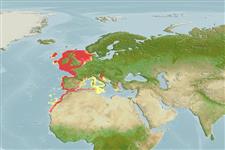Preferred temperature (Ref.
115969): 7.1 - 16.2, mean 10.3 (based on 462 cells).
Phylogenetic diversity index (Ref.
82804): PD
50 = 0.5000 [Uniqueness, from 0.5 = low to 2.0 = high].
Bayesian length-weight: a=0.00224 (0.00144 - 0.00349), b=3.27 (3.15 - 3.39), in cm Total Length, based on LWR estimates for this species & Genus-body shape (Ref.
93245).
مستوى غذائي (Ref.
69278): 3.8 ±0.61 se; based on food items.
المرونه (Ref.
120179): منخفض, الحد الزمني الأدني لتضاعف عدد أفراد المجتمع 4.5-14 سنة (K=0.12-0.19; tmax=15; Fec=40).
Prior r = 0.20, 95% CL = 0.13 - 0.30, Based on 1 full stock assessment.
Fishing Vulnerability (Ref.
59153): High to very high vulnerability (65 of 100).
Climate Vulnerability (Ref.
125649): High vulnerability (61 of 100).
